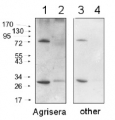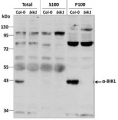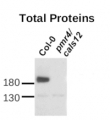1
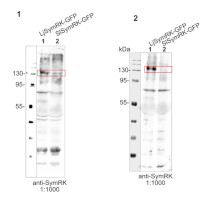
Anti-SymRK I Symbiosis receptor kinase
AS23 4899 | Clonality: Polyclonal | Host: Rabbit | Reactivity: Nicotiana benthamiana
- Product Info
-
Immunogen: KLH-conjugated peptide derived from SymRK protein from the following species: Oryza sativa, UniProt: Q7F1I0, Solanum lycopersicum, UniProt: Q2TDW9, Medicago truncatula, UniProt: Q8L4H4 Host: Rabbit Clonality: Polyclonal Purity: Antigen affinity purified serum, in PBS pH 7.4 Format: Lyophilized Quantity: 50 µg Reconstitution: For reconstitution add 50 µl, of sterile or deionized water. Storage: Store lyophilized/reconstituted at -20°C; once reconstituted make aliquots to avoid repeated freeze-thaw cycles. Please, remember to spin tubes briefly prior to opening them to avoid any losses that might occur from lyophilized material adhering to the cap or sides of the tubes. Tested applications: Western blot (WB) Recommended dilution: 1 : 1000 (WB) Expected | apparent MW: 64 | 101 | 104 kDa - Reactivity
-
Confirmed reactivity: Lotus japonicus Predicted reactivity: Brachypodium distachyon, Hordeum vulgare, Medicago truncatula, Nicotiana tabacum, Solanum lycopresicum, Solanum tuberosum, Oryza sativa Japonica, Pisum sativum, Sorghum bicolor, Triticum sp., Zea mays
Species of your interest not listed? Contact usNot reactive in: No confirmed exceptions from predicted reactivity are currently known - Application Examples
-
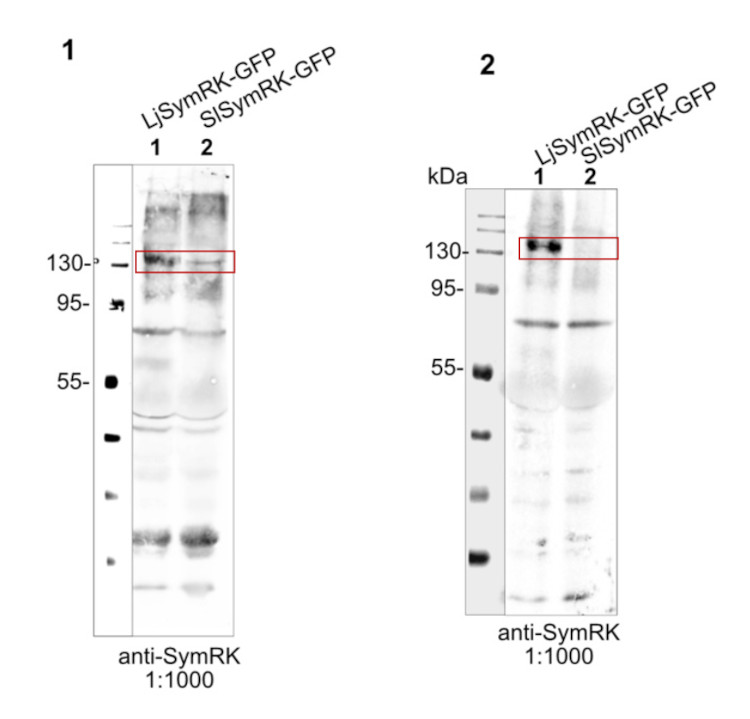
Samples, blot 1:
1 - Lotus japonicus (Lj) LjSymRK-GFP
2 - Solanum lycopersicum (Sl) SlSymRK-GFP
Marker: Color Prestained Protein Standard, Broad Range (10–250 kDa)
Samples, blot 2
1 - LjSymRK-GFP, (Lj: Lotus japonicus)
2- SlSymRK-GFP
Marker: Color Prestained Protein Standard, Broad Range (10–250 kDa)300 mg of frozen plant tissues from Nicotiana benthamiana transformed with 35S:LjSymRK-GFP or 35S:SlSymRK-GFP were grinded in liquid nitrogen and proteins were extracted freshly with 300 µL of extraction buffer (50 mM HEPES pH 7.5, 150 mM NaCl, 10 mM EDTA, 10% Sucrose, 1% Igepal, 2mM DTT, 1X Protease Inhibitor cocktail. The extract was incubated 30 min with agitation at 4°C, then centrifuged at full speed at 4°C for 10 minutes. Supernatant was collected and mixed with Sample Buffer. The extract was denaturated at 65°C for 5 minutes and loaded on a 10% SDS page. Then, it was blotted with wet transfer 2h 15 minutes at 4°C on Immobilon-FL PVDF, (pore size of 0,45 µm). Blot was blocked with 5% Milk/TBS-T for 1h at RT with agitation. Blot was incubated overnight with primary antibody with dilution of 1:1000 in 1% nonfat milk/TBS-T at 4°C with agitation. The antibody solution was decanted, and the blot was rinsed 3 times 10 minutes at RT with 1XTBS-T with agitation. Blot was incubated at RT for 1h with secondary antibodies anti-Rabbit IRDye 800 1:10000 (LICOR). The membrane was visualized with Odyssey scanner machine at 700 for the Marker and 800 for the antibody signal.
Courtesy of Dr. Katarzyna Parys, LMU Munich, Germany
- Background
-
Background: SymRK (Symbiosis receptor kinase) is an enzyme involved in the perception of symbiotic fungi and bacteria and perception and transduction system which is leading to nodulation or mycorrhizal infection. - Protocols
-
Agrisera Western Blot protocol and video tutorials
Protocols to work with plant and algal protein extracts
Agrisera Educational Poster Collection - Reviews:
-
This product doesn't have any reviews.
Accessories

AS14 2769 | Clonality: Polyclonal | Host: Rabbit | Reactivity: A. thaliana, A. madagascariensis, C. reinhardtii, Ch. dorsiventrale, G. hirsutum, H. lacustris, N. benthamiana, P. trichocarpa. S. lycopersicum, Z.mays

